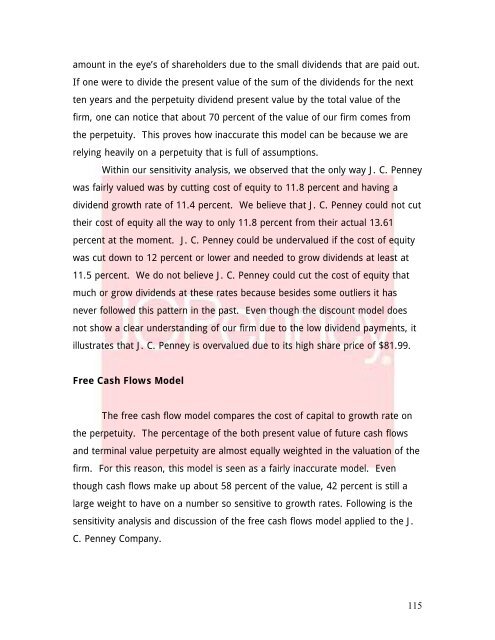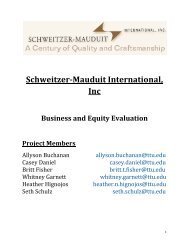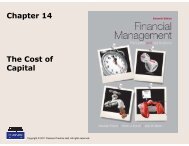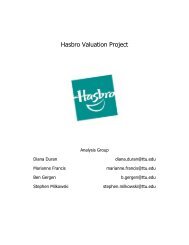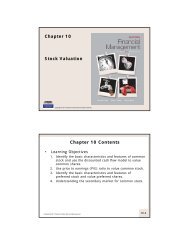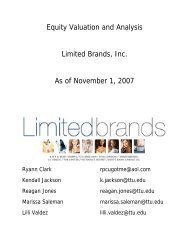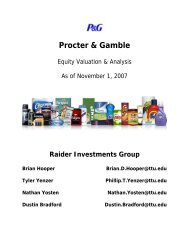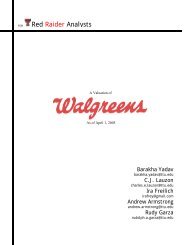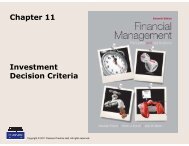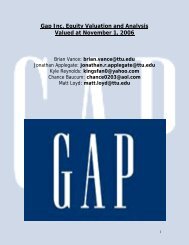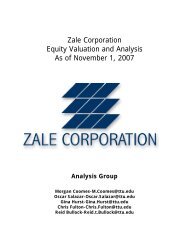J. C. Penney Company, Inc. Equity Valuation and Analysis As of ...
J. C. Penney Company, Inc. Equity Valuation and Analysis As of ...
J. C. Penney Company, Inc. Equity Valuation and Analysis As of ...
You also want an ePaper? Increase the reach of your titles
YUMPU automatically turns print PDFs into web optimized ePapers that Google loves.
amount in the eye’s <strong>of</strong> shareholders due to the small dividends that are paid out.If one were to divide the present value <strong>of</strong> the sum <strong>of</strong> the dividends for the nextten years <strong>and</strong> the perpetuity dividend present value by the total value <strong>of</strong> thefirm, one can notice that about 70 percent <strong>of</strong> the value <strong>of</strong> our firm comes fromthe perpetuity. This proves how inaccurate this model can be because we arerelying heavily on a perpetuity that is full <strong>of</strong> assumptions.Within our sensitivity analysis, we observed that the only way J. C. <strong>Penney</strong>was fairly valued was by cutting cost <strong>of</strong> equity to 11.8 percent <strong>and</strong> having adividend growth rate <strong>of</strong> 11.4 percent. We believe that J. C. <strong>Penney</strong> could not cuttheir cost <strong>of</strong> equity all the way to only 11.8 percent from their actual 13.61percent at the moment. J. C. <strong>Penney</strong> could be undervalued if the cost <strong>of</strong> equitywas cut down to 12 percent or lower <strong>and</strong> needed to grow dividends at least at11.5 percent. We do not believe J. C. <strong>Penney</strong> could cut the cost <strong>of</strong> equity thatmuch or grow dividends at these rates because besides some outliers it hasnever followed this pattern in the past. Even though the discount model doesnot show a clear underst<strong>and</strong>ing <strong>of</strong> our firm due to the low dividend payments, itillustrates that J. C. <strong>Penney</strong> is overvalued due to its high share price <strong>of</strong> $81.99.Free Cash Flows ModelThe free cash flow model compares the cost <strong>of</strong> capital to growth rate onthe perpetuity. The percentage <strong>of</strong> the both present value <strong>of</strong> future cash flows<strong>and</strong> terminal value perpetuity are almost equally weighted in the valuation <strong>of</strong> thefirm. For this reason, this model is seen as a fairly inaccurate model. Eventhough cash flows make up about 58 percent <strong>of</strong> the value, 42 percent is still alarge weight to have on a number so sensitive to growth rates. Following is thesensitivity analysis <strong>and</strong> discussion <strong>of</strong> the free cash flows model applied to the J.C. <strong>Penney</strong> <strong>Company</strong>.115


